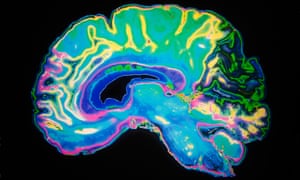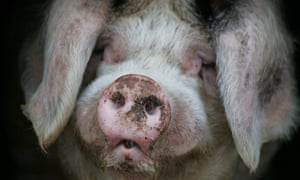What do you get when you fall in love?
We crave romantic love like nothing else, we’ll make unimaginable sacrifices for it and it can take us from a state of ecstasy to deepest despair. But what’s going on inside our heads when we fall in love?
The American anthropologist Helen Fisher describes the obsessive attachment we experience in love as “someone camping out in your head”.
In a groundbreaking experiment, Fisher and colleagues at Stony Brook University in New York state put 37 people who were madly in love into an MRI scanner. Their work showed that romantic love causes a surge of activity in brain areas that are rich in dopamine, the brain’s feelgood chemical. These included the caudate nucleus, part of the reward system, and an ancient brain area called the ventral tegmental area, or VTA. “[The VTA] is part of the reptilian core of the brain, associated with wanting, motivation, focus and craving,” Fisher said in a 2014 talk on the subject. Similar brain areas light up during the rush of euphoria after taking cocaine.

MRI scans of the brains of those in love found surges of activity of dopamine. Photograph: Daisy-Daisy/Alamy
During the early stages of love, the emotional excitement (or some might say stress) raises the body’s cortisol levels, causing a racing heart, butterflies in our stomach and inconveniently sweaty palms. Other chemicals in play are oxytocin, which deepens feelings of attachment, and vasopressin, which has been linked to trust, empathy and sexual monogamy.
So it’s a total eclipse of the head, not the heart?
Actually … in a case of science imitating poetry, the heart has been found to influence the way we experience emotion.
Our brain and heart are known to be in close communication. When faced with a threat or when we spot the object of our affection in a crowded room, our heart races. But recently, scientists have turned the tables and shown that feedback from our heart to our brain also influences what we are feeling.

What the heart is doing can influence how strongly our brain processes emotion. Photograph: Borja Suarez/Reuters
One study, led by Prof Sarah Garfinkel of the University of Sussex, showed that cardiovascular arousal – the bit of the heart’s cycle when it is working hardest – can intensify feelings of fear and anxiety. In this study, people were asked to identify scary or neutral images while their heartbeats were tracked. Garfinkel found they reacted quicker to the scary images when their heart was contracting and pumping blood, compared with when it was relaxing. Her work suggests that electrical signals from blood vessels around the heart feed back into brain areas involved in emotional processing, influencing how strongly we think we’re feeling something.
Finally, in what must be a contender for one of the most romantic (or mushy) scientific insights to date, couples have been shown to have a tendency to synchronise heartbeats and breathing.
Why is it a crazy little thing?
Love is merely a madness, Shakespeare wrote. But it is only recently that scientists have offered an explanation for why being in love might inspire unusual behaviour.
Donatella Marazziti, a professor of psychiatry at the University of Pisa, approached this question after carrying out research showing that people with obsessive compulsive disorder have, on average, lower levels of the brain chemical serotonin in their blood. She wondered whether a similar imbalance could underlie romantic infatuation.
She recruited people with OCD, healthy controls and 20 people who had embarked on a romantic relationship within the previous six months (it was also specified that they should not have had sexual intercourse and that at least four hours a day were spent thinking of the partner). Both the OCD group and the volunteers who were in love had significantly lower levels of serotonin, and the authors concluded “that being in love literally induces a state which is not normal”. When the “in love” group were followed up six months later, most of their serotonin levels had returned to normal.
A separate study found that people in love have much lower activity in their frontal cortex – an area of the brain crucial to reason and judgment – when they thought of their loved one. Scientists have speculated an evolutionary reason for this which could be termed the “beer goggles” theory: the suspension of reason makes coupling, and hence procreation, far more likely.
So all in love is fair – regardless of sexual orientation?
Sexual orientation has several components, including behaviour, identity, attraction and arousal.
Many scientific studies have been based on who people say they are attracted to, and surveys typically find that same-sex attraction accounts for fewer than 5% of the population, and this figure has remained relatively stable over time. But people’s behaviour and the labels they use to describe their sexual identity appear to be influenced to a greater degree by social and cultural factors.
For instance, in the UK there has been a sharp rise in the proportion of women reporting having had a sexual experience with another woman, from 1.8% in 1991 to 7.9% in 2013, according to the National Survey of Sexual Attitudes and Lifestyles, which is carried out each decade.
As with any scientific investigation, the way questions are framed also makes a difference to the answer. So studies that ask people to pick between two or three categories would miss any more subtle gradations. As Kinsey wrote in 1948: “The living world is a continuum in each and every one of its aspects. The sooner we learn this concerning human sexual behaviour, the sooner we shall reach a sound understanding of the realities of sex.”

Women are considerably more likely than men to rate themselves on a continuum of sexuality, Photograph: Sam Edwards/Getty Images/Caiaimage
There is growing support for the idea of a continuum, in particular for women who are considerably more likely than men to rate themselves as intermediate categories such as “mostly heterosexual” (10% v 4%), when given those options.
It’s worth noting that a 2011 study found no differences between brain systems regulating romantic love in homosexuals and heterosexuals.
Is there a gay gene?
It has been known for decades that sexual orientation is partly heritable in men, based on studies of identical and fraternal twins. In the 1990s, a specific region of the X chromosome was linked to male homosexuality and more recent two specific genes have been found to be more common in gay men.
However, the genetic factors that have been identified so far only play a small part in determining sexuality – not all men who have these genes are gay. Research on the genetic basis of female sexuality lags behind, which some have attributed to it being more difficult to study. Others might conclude that there has simply been less effort to understand this topic.
There are other biological factors at play as well. One of the most robust findings in sexual-orientation research is the fraternal-birth-order effect: gay men tend to have a greater number of older brothers compared with straight men. This is a biological influence rather than a social one and is a big effect, increasing the odds of a man being gay by roughly a third. In women, there is evidence that pre-natal hormone exposure can make a difference to sexual orientation.
Let’s get chemical: do humans give off pheromones?
Pheromones are chemical signals that are used to communicate and alter the behaviour of others. The first pheromone discovered, in the 1950s, was a substance called bombykol that female silkworms emit to attract males. Ever since then, the search has been on – not least by perfume manufacturers – to find a human equivalent. There have been some tentative claims.

A pheromone present in male pigs, androstenone, has also been found in the human armpit. Photograph: Joe Pepler/Rex Features
For instance, a known pig pheromone, androstenone, has been found in the human armpit. When female pigs on heat get a whiff of the substance, which is found in boars’ saliva, they adopt the mating stance. However, there is not yet any convincing evidence for real-life “Lynx effect” chemicals in men and women. The strongest contender to date for a human pheromone is a chemical secreted from glands in the nipples of breastfeeding mothers. When wafted under any sleeping baby’s nose, the child responds with sucking and rooting behaviour.
Your cheating heart – how uncommon is it?
Cheating is widely disapproved of, but is not that uncommon. According to the University of Chicago’s General Social Survey, men are on average more likely than women to be unfaithful – 20% of men and 13% of women reported that they’ve had sex with someone else while married.
However, the figures shifted across age ranges, with women in the youngest age range (18-29) being marginally more likely (11% v 10%) to have cheated, with the widest gender gap in the 80+ range where 24% of men and just 6% of women said they had been unfaithful.
Recently scientists have shown that some people may be genetically predisposed to being unfaithful. One study of nearly 7,400 Finnish twins and their siblings found a significant link between the vasopressin gene and infidelity in women.
Another study, by scientists at the Kinsey Institute, in Indiana, showed that certain variants of the gene for the dopamine receptor were more likely to be unfaithful and also more likely to be repeatedly unfaithful.
No comments:
Post a Comment